What is direct and alternating current definition. Alternating and direct current in technology
As we already know, electric current can be constant or alternating. But only alternating current is widely used. This is due to the fact that voltage and alternating current can be converted with virtually no energy loss. Alternating current obtained using alternating current generators using the phenomena of electromagnetic induction. In Fig. Figure 8 shows a primitive installation for generating alternating current.
Rice. 8.
The operating principle of the installation is simple. The wire frame rotates in a uniform magnetic field at a constant speed. The ends of the frame are fixed to rings that rotate with it. Springs that act as contacts fit tightly to the rings. A changing magnetic flux will continuously flow through the surface of the frame, but the flux created by the electromagnet will remain constant. In this regard, an induced emf will arise in the frame. In order to determine whether the magnetic flux passing along the surface of the frame is changing, you just need to compare the position of the frame at certain periods of time. To do this, you need to look carefully at Fig. 9.
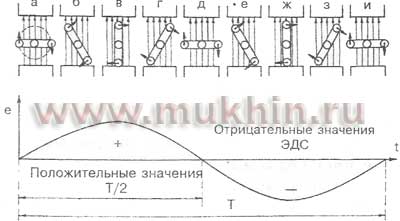
Rice. 9.
The reference point will be the position of the frame shown in Fig. 9, a. At this moment, the plane of the frame is perpendicular to the magnetic lines, and the magnetic flux will have its maximum value. The frame will appear parallel to the magnetic lines after a quarter of the period. The magnetic flux will then become zero, because not a single magnetic line passes through the surface of the frame. To determine the induced emf, you need to know not the magnitude of the flow, but the rate of its change. At the reference point, the induced emf is zero, and at the third (Fig. 9, c) it is the maximum value. Based on the positions of the frame, you can see that the induced emf changes both value and sign. Thus, it is variable (see graph in Fig. 9).
If the frame has only active resistance, then the current that appears in the circuit under the influence of induced emf will change over time, as will the emf itself. This current is called alternating sinusoidal current. The period of alternating current is the period of time during which the current performs one complete oscillation (this unit is denoted by the letter T). The number of complete oscillations in 1 s is called the frequency of the current and is denoted by the letter f. Frequency is measured in Hertz (Hz). In industry and everyday life, most countries use alternating current with a frequency of 50 Hz.
RMS values of current and voltage
As is known, alternating induced emf causes alternating current in the circuit. At the highest EMF value, the current strength will have a maximum value and vice versa. This phenomenon is called phase matching. Although current values can fluctuate from zero to a certain maximum value, there are instruments with which you can measure the strength of alternating current.
The characteristic of alternating current can be actions that do not depend on the direction of the current and can be the same as with direct current. These actions include thermal action. For example, alternating current flows through a conductor with a given resistance. After a certain period of time, a certain amount of heat will be released in this conductor. It is possible to select a value of direct current such that the same amount of heat is generated on the same conductor during the same time by this current as with alternating current. This value of direct current is called the effective value of alternating current.
Ammeters and voltmeters of the magnetoelectric system do not allow measurements in alternating current circuits. This happens because with each change in the current in the coil, the direction of the torque changes, which affects the arrow of the device. Due to the fact that the coil and pointer have high inertia, the device does not respond to alternating current. For these purposes, devices are used that do not depend on the direction of the current. For example, these could be devices based on the thermal effect of current. In such devices, the needle rotates due to the extension of the thread, heated by the current.
You can also use devices with an electromagnetic operating system. The moving part in these devices is an iron disk of small diameter. It is remagnetized and drawn into the coil through which alternating current is passed. Such devices measure the effective values of current and voltage.
Inductor and capacitor in AC target
Features of alternating current are changes in the strength and direction of the current. These phenomena distinguish it from direct current. For example, you cannot charge a battery using alternating current. It also cannot be used for other technical purposes.
The strength of alternating current is directly dependent not only on voltage and resistance, but also on the inductance of the conductors connected to the circuit. Typically, inductance significantly reduces the strength of alternating current. Due to the fact that the resistance of the circuit is equal to the ratio of voltage to current, connecting an inductor to the circuit will increase the total resistance. This will happen due to the presence of self-induction EMF, which prevents the current from increasing. If the voltage changes, then the current simply does not have time to reach the maximum values that it would have acquired without self-induction. It follows from this that highest value AC strength is limited by inductance, i.e. the greater the inductance and frequency of the voltage, the lower the current value will be.
If a bank of capacitors is connected to a DC circuit, then there will be no current in the circuit, because the capacitor plates are separated from each other by insulating spacers. If there is a capacitor in the circuit D.C. cannot exist.
If exactly the same battery is connected to an alternating current circuit, a current will arise in it. This is explained as follows. Under the influence of changing voltage, capacitors are charged and discharged. That is, if one plate of the capacitor had a negative charge during any half-cycle, then in the next half-cycle it will acquire a positive charge. Therefore, recharging the capacitor moves charges through the circuit. And this is electric current, which can be detected using an ammeter. The greater the charge being moved, the greater the current, i.e., the greater the capacitance of the capacitor and the more often it is recharged, the greater the frequency.
Three-phase alternating current
Currently, three-phase alternating current is widely used in global industrial practice, which has many advantages over single-phase current. A three-phase system is called a system that has three electrical circuits with their own variable emfs with the same amplitudes and frequencies, but shifted in phase relative to each other by 120° or 1/3 of the period. Each such circuit is called a phase.

Rice. 10.
To obtain a three-phase system, you need to take three identical single-phase alternating current generators and connect their rotors to each other so that they do not change their position when rotating. The stator windings of these generators must be rotated relative to each other by 120° in the direction of rotor rotation. An example of such a system is shown in Fig. 10.
According to the above conditions, it turns out that the EMF arising in the second generator will not have time to change compared to the EMF of the first generator, i.e. it will be delayed by 120°. The EMF of the third generator will also be delayed by 120° relative to the second.
However, this method of producing alternating three-phase current is very cumbersome and economically unprofitable. To simplify the task, you need to combine all the stator windings of the generators in one housing. Such a generator is called a three-phase current generator. When the rotor begins to rotate, a changing induced emf occurs in each winding. Due to the fact that the windings shift in space, the oscillation phases in them also shift relative to each other by 120°.
In order to connect a three-phase alternator to a circuit, you need to have 6 wires. To reduce the number of wires, the windings of the generator and receivers need to be connected to each other, forming a three-phase system. There are two types of connections: star and triangle. When using both methods, you can save electrical wiring.
Star connection
Typically, a three-phase current generator is depicted as 3 stator windings, which are located at an angle of 120° to each other. The beginnings of the windings are usually designated by the letters A, B, C, and the ends by X, Y, Z. In the case when the ends of the stator windings are connected to one common point (zero point of the generator), the connection method is called “star”. In this case, wires called linear are connected to the beginnings of the windings (Fig. 11 on the left).
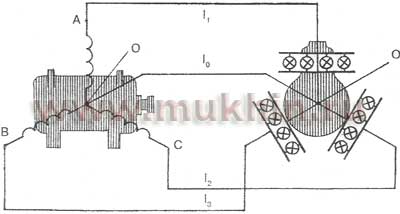
Rice. eleven.
Receivers can be connected in the same way (Fig. 11 on the right). In this case, the wire that connects the zero point of the generator and receivers is called zero. This three-phase current system has two different voltages: between the line and neutral wires or, what is the same, between the beginning and end of any stator winding. This value is called phase voltage (Ul). Since the circuit is three-phase, the linear voltage will be v3 times greater than the phase voltage, i.e.:
Ul = v3Uф
Delta connection

Rice. 12.
When using this connection method, the X end of the first winding of the generator is connected to the beginning B of its second winding, the Y end of the second winding is connected to the beginning C of the third winding, and the Z end of the third winding is connected to the beginning A of the first winding. An example of a connection is shown in Fig. 12. With this method of connecting phase windings and connecting a three-phase generator to a three-wire line, the linear voltage is compared in value to the phase voltage:
Nowadays, electric current is used in all sectors of the national economy. And we know that current is of two types: direct and alternating. Let us recall that at constant current the electrons in electrical circuit They move all the time in one direction, and with alternating current they continuously change direction. What kind of current - alternating or direct - is needed more by technology and industry?
Transmission of electrical energy over long distances is possible only at high current voltages, reaching 110, 220, 400 and even 500-800 thousand. V. And the generator of an electric station is capable of creating a voltage no higher than 20 thousand. V. At the same time, various electrical machines and devices require an electric current of only a few tens or hundreds of volts. This is where alternating current turns out to be indispensable. After all, it allows you to easily change the voltage within any limits using transformers: increase it at power plants for transmission over long distances and decrease it again directly at consumers.
At the end of the last century, the Russian electrical engineer M. O. Dolivo-Dobrovolsky received three-phase alternating current, which has very important advantages. Firstly, three-phase power lines are more profitable than single-phase ones: with the same cost of wires and insulation, more energy can be transmitted through them than through single-phase ones. And secondly, thanks to the property of three-phase alternating current to create a rotating magnetic field, it was possible to build very simple and reliable asynchronous electric motors, which are now widely used to drive machine tools and machines.
These qualities of alternating current allowed it to take a leading position in technology and were the reason that today all industrial power plants produce only three-phase alternating current. 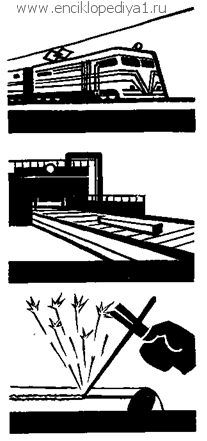
More than half of the generated electrical energy is consumed by electric motors. In addition to simple asynchronous motors that do not have a winding on the rotor, there are motors with a winding and slip rings on the rotor. Such motors develop great forces when starting, and therefore they are most often used on cranes. There are also synchronous motors that have a constant rotation speed. Due to this, they are used in machines and mechanisms that require a constant speed of movement regardless of their load: in subway escalators, large water pumps, electric clocks, etc. Electric motors are small, smaller than a spool of thread, and as big as a carousel.
The use of several electric motors to drive machine tools at once made it possible to eliminate a complex transmission system, simplify the mechanisms of machine tools, make it easier to control them and make it possible to create automatic lines.
The small size and simplicity of electric motors made it possible to use electrical energy where previously only manual labor was used. Electric drills, saws, planes, impact wrenches and other tools have made the work of workers much easier and made it more productive. Electric floor polishers, vacuum cleaners, washing machines and refrigerators have come to the aid of housewives. And even earlier, electric kettles, irons, and stoves appeared in homes.
Alternating current is a good source of heat. Metal is melted and cooked in powerful electric arc furnaces. Electric furnaces are widely used in “artificial climate” installations, for heating drying cabinets and rooms, heating metals, etc.
Light bulbs shine regardless of the current passing through their filaments: alternating or direct. But AC transmission is more economical, and transformers make it easy to obtain and maintain the required voltage. Therefore, the lighting network of cities and villages is powered by alternating current.
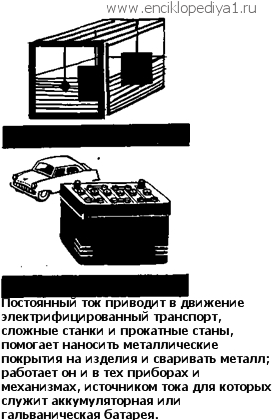 But then we got on a tram, a trolleybus, a subway car, a commuter train - and immediately found ourselves in the domain of direct current. The fact is that simple and convenient AC electric motors do not allow smooth changes in their rotation speed. And you have to change the speed of movement almost continuously; Only a DC traction motor can do this job well.
But then we got on a tram, a trolleybus, a subway car, a commuter train - and immediately found ourselves in the domain of direct current. The fact is that simple and convenient AC electric motors do not allow smooth changes in their rotation speed. And you have to change the speed of movement almost continuously; Only a DC traction motor can do this job well.
Such motors are powered from special traction rectifier substations, at which alternating current is converted into direct current, and then supplied to the contact network - into wires and rails.
But scientists and engineers wondered whether alternating current could be used in transport. It turned out it was possible. And now on many railways in contact wires alternating current flows with a voltage of up to 25 thousand V, and in the future all railways. But the motors of electric locomotives still operate on direct current: rectifier units that convert alternating current into direct current are also located on electric locomotives in this case.
With the help of direct current electric motors, the wheels of diesel locomotives, the mechanisms of rolling mills, walking excavators and many other machines are driven.
There is an even larger and more important area in which alternating current cannot compete with direct current. We are talking about electrolysis - a process associated with the passage of current through liquid solutions - electrolytes. Under the influence of direct current, the electrolyte decomposes into individual elements, which are deposited on the electrodes lowered into the electrolyte. Aluminum, magnesium, zinc, copper, and manganese are obtained in this way. In the chemical industry, fluorine, chlorine, hydrogen and other substances are produced using electrolysis. Using electrolysis, protective coatings are applied to metal products (see article “”).
Direct current successfully competes with alternating current in welding (see article “How to weld metal”). When welding with direct current, metal particles are transferred from the electrode to the product more correctly and the seam is better than when welding with alternating current.
Direct current has one more feature. Rather, not at the current itself, but at its sources. To obtain alternating electric current, it is imperative to set the generator in motion, and stationary batteries and galvanic cells can provide direct current. These properties of electric current sources in some cases force one to give preference to direct current. For example, how to start the engine of a stationary car? Simply press the starter button and the DC motor, powered by the battery, will start the engine. And when the engine is running, it rotates the generator, which recharges the battery. Such a reversible process is not possible with alternating current.
Many mines operate electric locomotives with batteries, and in factory workshops, train stations and warehouses you can often find small electric carts with batteries - electric cars.
Large batteries are used to power signaling, control and emergency lighting devices in power plants, trains and even trolleybuses. Lightweight batteries and galvanic batteries are used in portable radio stations, radio receivers, electric lights, measuring and other instruments.
And remember about artificial Earth satellites and spacecraft: they are equipped with semiconductor solar batteries - they also provide direct electric current (see article "").
Before finishing our story, let's return briefly to its beginning - to the transmission of electrical energy through wires. The transmitted power and the length of power lines are constantly increasing, and it is necessary to increase the voltage to 500 and even 800 thousand. V.
And it turned out that under these conditions it is more profitable to transmit electrical energy using direct current. Insulation is used twice as well, the capacity of overhead power lines increases, the number of wires decreases... It is important that there is no need for a complex synchronization process when switching on lines connecting large power plants or energy systems. This is, perhaps, quite enough to prove the feasibility of using direct current for ultra-long-distance energy transfers. True, to obtain high-voltage direct current and subsequently convert it into low-voltage alternating current, very complex and expensive converter substations are needed. But, despite this, calculations show that in some cases it is still more profitable to use direct current for heavy-duty and ultra-long-distance power transmissions. Therefore, work is already underway on the construction of such direct current power lines.
Of course, the examples listed here do not exhaust all areas of application of electrical energy. Nothing is said here about its use for telegraph and telephone communications, for radio and television and other purposes, but you will read about this in other articles in this volume. One thing is clear: we need both alternating and direct current, and one of them will never displace the other. On the contrary, the intelligent use of both allows for better and more complete use of electrical energy for the benefit of humans.
Alternating current is an electric current that changes in direction and magnitude at equal periods. Also considered variable is the current arising in single-phase and three-phase networks. For existing devices that consume, AC conversion is carried out using special rectifiers.
The emergence of alternating current
In order for current to arise in an electrical circuit, special sources are used to generate it, which create an alternating electromotive force (EMF). The electromotive force periodically changes in magnitude and direction. EMF sources are actually alternating current generators.
The simplest circuit for generating alternating current is shown in the figure:
This device consists of two main parts. The fixed part is a magnet that forms a magnetic field between its poles. The density of magnetic field lines is the same, so the magnetic field is uniform. The moving part of the device is a rectangular frame. It is made of copper wire, fixed on a longitudinal axis and rotates in a magnetic field with the help of an external driving force. The output ends are connected to copper slip rings. The rings rotate simultaneously with the frame and slide along the brushes.
To ensure that a given device actually produces an alternating electromotive force, we apply the well-known “right-hand rule.”
The right hand is positioned in such a way that the palm faces the “north” direction of our magnet. In this case, the thumb is bent in the direction of movement of that side of the copper frame where the direction of the EMF should be determined. The direction of the outstretched fingers will also show us the direction of the EMF. When determining the EMF in different directions, the value will ultimately be common. In addition, with each revolution the direction of the EMF changes. This occurs due to the fact that the working sides of the frame pass under different poles of the magnet during one revolution.
The emergence of electromotive force
The magnitude of the electromotive force that is induced in the frame changes with the speed of intersection of the magnetic field lines. In a vertical position, the crossing speed is maximum. The EMF in the frame is also maximum. When the frame passes through a horizontal position, the sides do not intersect the magnetic lines of force, the induction of EMF does not 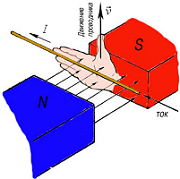 is produced.
is produced.
From all this it follows that uniform rotation of the frame provides an induction of EMF, which uniformly changes in magnitude and direction. The electromotive force arising in the frame ultimately creates an alternating current in the external circuit.
We looked at the classic scheme for generating alternating current. It is actually generated using an alternator. Here the electromagnet, on the contrary, rotates and has two or more poles. It is called a rotor. The role of the frame is played by the stator winding (fixed part), from which it is removed AC voltage. For industrial production, generation is carried out using generators of various capacities installed at power plants (hydroelectric power plants, state district power plants, nuclear power plants).
Current is the movement of electrons in a certain direction. It is necessary for electrons to move in our devices too. Where does the current in the outlet come from?
A power plant converts the kinetic energy of electrons into electrical energy. That is, a hydroelectric power plant uses running water to rotate a turbine. The turbine propeller rotates a ball of copper between two magnets. Magnets force the electrons in the copper to move, which causes the electrons in the wires that are connected to the ball of copper to move, resulting in a current.
The generator is like a water pump, and the wire is like a hose. The generator-pump pumps electrons-water through wires-hoses.
Alternating current is the current that we have in the outlet. It is called variable because the direction of electron motion is constantly changing. AC power from outlets has different frequencies and electrical voltages. What does it mean? In Russian sockets the frequency is 50 hertz and the voltage is 220 volts. It turns out that in a second the flow of electrons changes the direction of electron movement and the charge from positive to negative 50 times. You can notice a change in direction in fluorescent lamps when you turn them on. While the electrons are accelerating, it blinks several times - this is a change in direction of movement. And 220 volts is the maximum possible “pressure” with which electrons move in this network.
In alternating current, the charge is constantly changing. This means that the voltage is either 100%, then 0%, then 100% again. If the voltage were 100% constant, then a huge diameter wire would be needed, but with varying charge the wires could be thinner. It's comfortable. A power plant can send millions of volts through a small wire, then a transformer for an individual house takes, for example, 10,000 volts, and delivers 220 to each outlet.
Direct current is the current you have in your phone battery or batteries. It is called constant because the direction in which the electrons move does not change. Charging device They transform alternating current from the network into direct current, and in this form it ends up in batteries.
What is alternating current?
The bulk of beginning radio amateurs begin their study of electronics with the basics of direct current (DC), which flows in one direction and/or has a voltage of constant polarity. Direct current is the type of electricity produced by batteries (which have positive and negative terminals) or the type of charge produced certain friction types of materials about each other.
However, direct current is not the only type of electricity. Some power sources (primarily rotary electromechanical generators) produce a voltage whose polarity changes over time. This type of electricity is known as alternating current (AC):
Just as the familiar symbol of a battery is used to represent any DC voltage source, a circle with a wavy line inside is used to represent any AC voltage source.
One might think that the practical applications of alternating current are limited. Indeed, in some cases, alternating current is inferior to direct current in terms of practical application. In systems where electricity is used to dissipate energy in the form of heat, the polarity or direction of the current does not matter - it is sufficient that the voltage and current be sufficient for the load to produce the necessary heat (energy dissipation). However, by using alternating current, much more efficient electric generators, electric motors and power distribution systems can be created. Due to this, the use of alternating current predominates in high-power systems. To understand why this is so, we need to know a little more about alternating current itself.
According to Faraday's law of electromagnetic induction, the electromotive force arising in a closed conducting circuit is proportional to the rate of change of the magnetic flux through the surface limited by this circuit. This is the fundamental operating principle of an alternator, or alternator.

Alternator operating principle
Notice how the polarity of the voltage on the coils changes when, when rotating, different poles of the magnet appear near them. When connected to a load, such a voltage will create a current that periodically changes the direction of its movement. The faster the alternator shaft rotates, the faster the magnet will rotate, and the more often the voltage will change polarity, and the current will change direction over a certain period of time.
Despite the fact that DC generators operate on the same principle of electromagnetic induction, their design is much more complex than that of their rivals, alternating current generators. In DC generators, the winding is located on the shaft (alternators have a magnet on the shaft), and this rotating winding comes into contact with stationary carbon “brushes”. This design is necessary to switch the changing polarity at the output of the coil to an external circuit, so that a constant polarity is created on the latter:
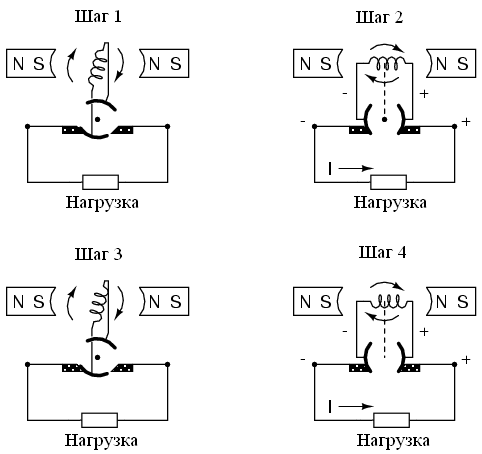
Operating principle of a DC generator
The generator shown in this figure produces two voltage pulses per shaft rotation. Both pulses have the same polarity. In order for the DC generator to produce permanent voltage, rather than short pulses for each half-cycle of rotation, creates a set of windings that periodically come into contact with the brushes. The above figure shows in simplified form what you will see in practice.
Problems associated with the occurrence and interruption of electrical contact when the winding moves are obvious (sparking and overheating), especially if the generator shaft rotates at high speed. If the environment around the generator contains flammable or explosive vapors, sparking problems will be exacerbated. To operate the alternator (alternator), no brushes or commutators are required, so it is protected from the problems inherent in DC generators.
AC generators have obvious advantages over DC generators when used as electric motors. Unlike DC motors, AC motors do not suffer from the problem of brushes coming into contact with the moving winding. Direct and alternating current electric motors are very similar in design to the corresponding electric generators.
Thus, it becomes clear that the design of AC generators and electric motors is much simpler than the design of DC generators and electric motors. The relative simplicity of these devices in practice results in much greater reliability and cost-effectiveness. What else is alternating current used for? Surely there must be something else besides using it in generators and electric motors! Indeed, the range of applications of alternating current is very wide. Surely you have heard about such a phenomenon as mutual induction. It occurs when two or more windings are placed in such a way that the alternating magnetic field created by one of the windings induces a voltage in the other. If we apply alternating voltage to one winding, then we will also receive alternating voltage to the other. Such a device is known as a transformer.

The main purpose of a transformer is its ability to increase and decrease the voltage on the secondary winding. The AC voltage generated in the secondary winding is equal to the AC voltage on the primary winding multiplied by the turns ratio factor secondary winding to the number of turns of the primary. If current is supplied from the secondary winding to the load, then the change in current on the secondary winding will be exactly the opposite: the current of the primary winding is multiplied by the ratio of the number of turns of the primary to the number of turns of the secondary winding. A mechanical analogue of such relationships is the example with torque and speed (instead of voltage and current, respectively):

If the ratio of winding turns is reversed, i.e. Since the primary winding has fewer turns than the secondary, the transformer increases the source voltage to a higher level:
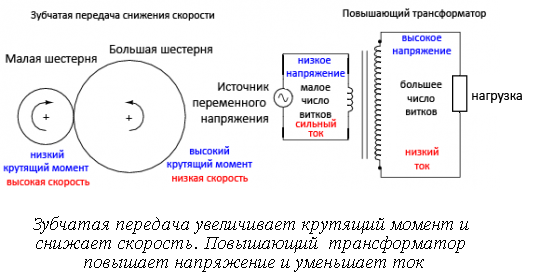
The transformer's ability to step up and step down AC voltage gives AC a distinct advantage over DC in power distribution (see figure below). It is much more efficient to transmit electricity over long distances when high voltage and low current (smaller diameter wires with less resistance losses), and then lower the voltage and increase the current when supplying energy to end consumers.

Thanks to transformers, transmitting electrical energy over long distances has become much more practical. Without the ability to effectively increase and decrease voltage, it would be prohibitively expensive to create power supply systems for long distances (more than several tens of kilometers).
Transformers require only alternating current to operate. Since the phenomenon of mutual induction is based on alternating magnetic fields, transformers simply will not operate on direct current(direct current can only create constant magnetic fields). Of course, a constant intermittent (pulsed) current can be applied to the primary winding of a transformer to create an alternating magnetic field (as is done in an automobile ignition system to create a spark in a spark plug from a low-voltage DC battery), but in this embodiment, a pulsed direct current does nothing different from variable. It is perhaps for this reason that alternating current is becoming more widely used in power systems.














